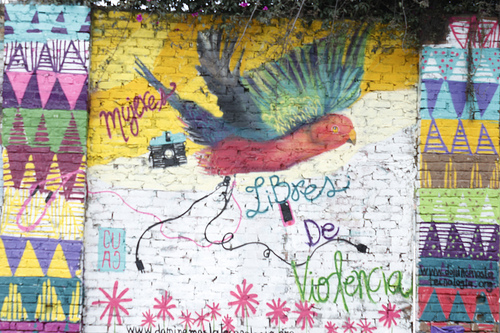
Image from Take Back the Tech! campaign in Colombia, Colnodo
Today is the International Day for the Elimination of Violence Against Women, a day that honours the Mirabal sisters, links gender-based violence to human rights and marks the start of 16 Days of Activism Against Gender-Based Violence (GBV). As Take Back the Tech! launches a 16 Days campaign exploring the movement against GBV, it's important to consider how this movement began.
Although women have resisted violence in a variety of ways throughout history, women's right to live free from violence was not formally recognised at an international level until the late twentieth century. In 1979 the United Nations adopted the Convention on the Elimination of all Forms of Discrimination Against Women (CEDAW), an international treaty since ratified by 189 nations, though with reservations in many instances. The only states that have not either signed or ratified the treaty are the Holy See, Iran, Niue, Palau, Somalia, Sudan, Tonga and the United States.
In 1993 the Vienna Declaration and Programme of Action, a human rights declaration adopted at the World Conference on Human Rights, urged the United Nations General Assembly to adopt the Declaration on the Elimination of Violence Against Women, claiming,
Gender-based violence and all forms of sexual harassment and exploitation, including those resulting from cultural prejudice and international trafficking, are incompatible with the dignity and worth of the human person, and must be eliminated. This can be achieved by legal measures and through national action and international cooperation in such fields as economic and social development, education, safe maternity and health care, and social support.
A few months later, the UN did indeed adopt the Declaration on the Elimination of Violence Against Women, which states:
Women are entitled to the equal enjoyment and protection of all human rights and fundamental freedoms in the political, economic, social, cultural, civil or any other field. These rights include, inter alia:
(a) The right to life;
(b) The right to equality;
(c) The right to liberty and security of person;
(d) The right to equal protection under the law;
(e) The right to be free from all forms of discrimination;
(f) The right to the highest standard attainable of physical and mental health;
(g) The right to just and favourable conditions of work;
(h) The right not to be subjected to torture, or other cruel, inhuman or degrading treatment or punishment.
Finally, in 1995 the Fourth World Conference on Women produced the Beijing Declaration and Platform for Action, a set of principles affirming gender equality and recommendations on twelve areas of concern, including violence against women. These important documents paved the way for states to take action on GBV, but advocates and activists created the political will for UN and government representatives to take on these issues. In fact, the 1995 conference saw an unprecedented 17,000 participants and 30,000 activists come together in Beijing from around the world to advance women's human rights.
Two years before the Declaration on the Elimination of Violence Against Women, the Center for Women's Global Leadership at Rutgers University started 16 Days of Activism Against Gender-Based Violence, running from the International Day for the Elimination of Violence Against Women on 25 November to Human Rights Day on 10 December. One of the first actions 16 Days was to get people to sign a petition calling upon the Preparatory Committee of the 1993 conference in Vienna to comprehensively address women's human rights and recognise GBV as a human rights violation. Without the benefit of today's digital technology, the campaign managed to gather one million signatures!
More than 5,000 organisations in 187 countries have led or participated in 16 Days campaigns, not including the numerous individuals who join the call each year, and Take Back the Tech! has been part of 16 Days since our inception in 2006. Learn more about the history of Take Back the Tech! through our interactive timeline. Did you know our name was inspired by the Take Back the Night marches that started on university campuses in cities like Philadelphia and Brussels?
Marches and other offline actions remain a vital component of the movement despite the power of hashtags like #MeToo, #NiUnaMenos and #BringBackOurGirls. Just last year, hundreds of thousands of women across Latin America marched as part of Ni Una Menos, and this year an estimated five million joined the Women's March in 82 countries. But there are smaller marches and demonstrations all the time as well as other actions that do not get much coverage, and there is a wealth of invisible work that sustains the movement.
Revisiting our history strengthens our current resistance. Find actions in our campaign call and join us on this journey to uncover stories and lessons that will increase our collective power. Direct your browser to tap into the strength of the many activists who came before us and who come together now. Revisit to resist! Take back the tech!
Upload your artefacts to the Museum of Movements.
Join the conversation at #FeministMemory.
Follow us at @takebackthetech.
SaveSaveSaveSaveSaveSaveUpload your artefacts to the Museum of Movements.
Join the conversation at #FeministMemory.
Follow us at @takebackthetech.
- Log in to post comments
